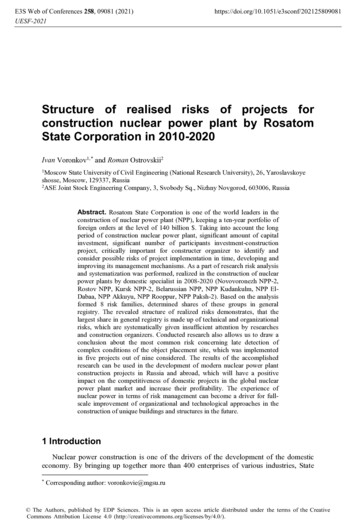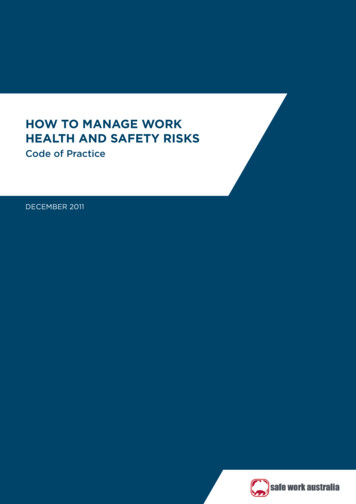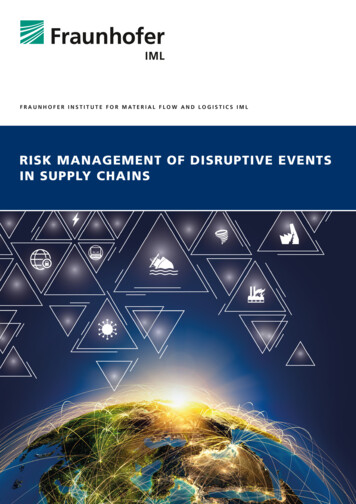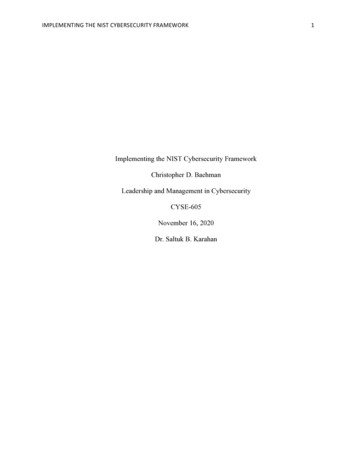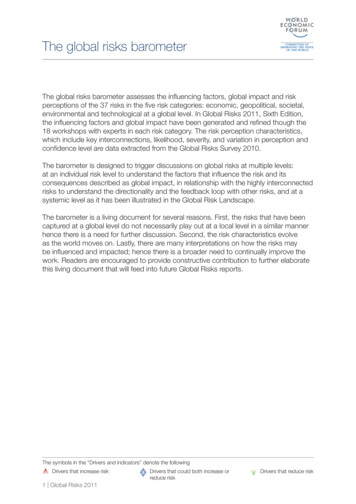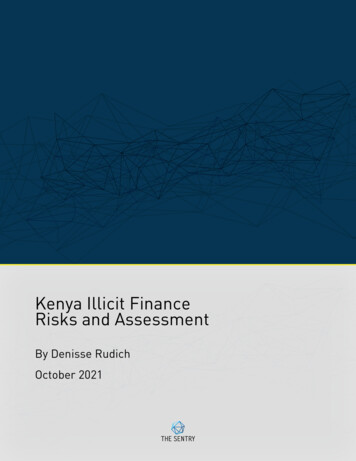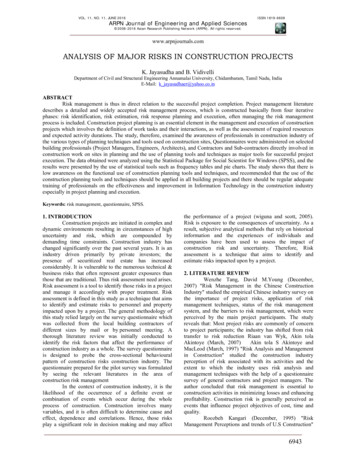
Transcription
VOL. 11, NO. 11, JUNE 2016ISSN 1819-6608ARPN Journal of Engineering and Applied Sciences 2006-2016 Asian Research Publishing Network (ARPN). All rights reserved.www.arpnjournals.comANALYSIS OF MAJOR RISKS IN CONSTRUCTION PROJECTSK. Jayasudha and B. VidivelliDepartment of Civil and Structural Engineering Annamalai University, Chidambaram, Tamil Nadu, IndiaE-Mail: k jayasudhaer@yahoo.co.inABSTRACTRisk management is thus in direct relation to the successful project completion. Project management literaturedescribes a detailed and widely accepted risk management process, which is constructed basically from four iterativephases: risk identification, risk estimation, risk response planning and execution, often managing the risk managementprocess is included. Construction project planning is an essential element in the management and execution of constructionprojects which involves the definition of work tasks and their interactions, as well as the assessment of required resourcesand expected activity durations. The study, therefore, examined the awareness of professionals in construction industry ofthe various types of planning techniques and tools used on construction sites, Questionnaires were administered on selectedbuilding professionals (Project Managers, Engineers, Architects), and Contractors and Sub-contractors directly involved inconstruction work on sites in planning and the use of planning tools and techniques as major tools for successful projectexecution. The data obtained were analyzed using the Statistical Package for Social Scientist for Windows (SPSS), and theresults were presented by the use of statistical tools such as frequency tables and pie charts. The study shows that there islow awareness on the functional use of construction planning tools and techniques, and recommended that the use of theconstruction planning tools and techniques should be applied in all building projects and there should be regular adequatetraining of professionals on the effectiveness and improvement in Information Technology in the construction industryespecially in project planning and execution.Keywords: risk management, questionnaire, SPSS.1. INTRODUCTIONConstruction projects are initiated in complex anddynamic environments resulting in circumstances of highuncertainty and risk, which are compounded bydemanding time constraints. Construction industry haschanged significantly over the past several years. It is anindustry driven primarily by private investors; thepresence of securitized real estate has increasedconsiderably. It is vulnerable to the numerous technical &business risks that often represent greater exposures thanthose that are traditional. Thus risk assessment need arises.Risk assessment is a tool to identify those risks in a projectand manage it accordingly with proper treatment. Riskassessment is defined in this study as a technique that aimsto identify and estimate risks to personnel and propertyimpacted upon by a project. The general methodology ofthis study relied largely on the survey questionnaire whichwas collected from the local building contractors ofdifferent sizes by mail or by personnel meeting. Athorough literature review was initially conducted toidentify the risk factors that affect the performance ofconstruction industry as a whole. The survey questionnaireis designed to probe the cross-sectional behaviouralpattern of construction risks construction industry. Thequestionnaire prepared for the pilot survey was formulatedby seeing the relevant literatures in the area ofconstruction risk managementIn the context of construction industry, it is thelikelihood of the occurrence of a definite event orcombination of events which occur during the wholeprocess of construction. Construction involves manyvariables, and it is often difficult to determine cause andeffect, dependence and correlations. Hence, those risksplay a significant role in decision making and may affectthe performance of a project (wiguna and scott, 2005).Risk is exposure to the consequences of uncertainty. As aresult, subjective analytical methods that rely on historicalinformation and the experiences of individuals andcompanies have been used to assess the impact ofconstruction risk and uncertainty. Therefore, Riskassessment is a technique that aims to identify andestimate risks impacted upon by a project.2. LITERATURE REVIEWWenzhe Tang, David M.Young (December,2007) "Risk Management in the Chinese ConstructionIndustry" studied the empirical Chinese industry survey onthe importance of project risks, application of riskmanagement techniques, status of the risk managementsystem, and the barriers to risk management, which wereperceived by the main project participants. The studyreveals that: Most project risks are commonly of concernto project participants; the industry has shifted from risktransfer to risk reduction Riaan van Wyk, Akin tolaAkintoye (March, 2007)Akin tola S Akintoye andMacLeod (March, 1997) "Risk Analysis and Managementin Construction" studied the construction industryperception of risk associated with its activities and theextent to which the industry uses risk analysis andmanagement techniques with the help of a questionnairesurvey of general contractors and project managers. Theauthor concluded that risk management is essential toconstruction activities in minimizing losses and enhancingprofitability. Construction risk is generally perceived asevents that influence project objectives of cost, time andquality.Roozbeh Kangari (December, 1995) "RiskManagement Perceptions and trends of U.S Construction"6943
VOL. 11, NO. 11, JUNE 2016ISSN 1819-6608ARPN Journal of Engineering and Applied Sciences 2006-2016 Asian Research Publishing Network (ARPN). All rights reserved.www.arpnjournals.comdiscussed the attitude of large U.S construction firmstoward and determined how the contractors conductconstruction risk management through a survey of the top100 contractors. The study showed that in the recent yearscontractors are more willing to assume risks thataccompany actual and legal problem in the form of risksharing with the owner.Florence Yean Yug Ling and Linda Hoi(December, 2006) "Risk faced by Singapore firms whenundertaking construction projects in India" studied the riskthat Singapore architecture, engineering and construction(AEC) firms face when working in India and investigatedthe risk response techniques adopted by them. The riskresponse techniques include having adequate insurancesand careful planning and management.Robin K Mcguire(June, 1999) "Analyzing of RiskFactors in Construction" This study helps to make the riskfactors involved in construction during and after theconstruction about the resource allocation, procurement,inventory control. And to minimize the time, cost andincrease in quality of construction by analyzing the riskduring planning itself.J.H.M. Tah and V.Carr (July, 2002) "KnowledgeBased Approach to Construction Project RiskManagement" suggested that consistent methodology forconstruction project risk management. The constructionindustry consistently suffers from poor projectperformance due to a lack of formalized risk managementprocedures which helps to facilitate more effective riskmanagement while allowing all project participants todevelop and share a great understanding of project risk forimproved performance.Mulholl. B and J. Christian (February, 1999)"Risk Assessment in Construction Schedules" suggestedthat a description of systematic way to consider andquantify uncertainty in construction schedules.Construction projects are initiated in complex anddynamic environments resulting in circumstances of highuncertainty and risk, which are demanding time constrains.3. RISK CONCEPTSRisk is a multi-facet concept. In the context ofconstruction industry, it could be the likelihood of theoccurrence of a definite event/factor or combinationof events/factors which occur during the whole process ofconstruction to the detriment of the project a lack ofpredictability about structure outcome or consequences ina decision or planning situation, the uncertainty associatedwith estimates of outcomes - there is a chance that resultscould be better than expected as well as worse thanexpected etc. In addition to the different definitions of risk,there are various ways for categorizing risk for differentpurposes too. Some categorize risks in constructionprojects broadly into external risks and internal risks whileothers classify risk in more detailed categories of politicalrisk, financial risk, market risk, intellectual property risk,social risk, safety risk, etc. The classification is shown inthe Figure-1. The typology of the risks seems to dependmainly upon whether the project is local (domestic) orinternational.Figure-1. Hierarchical risks involved in a project.a) Project risk managementRisk management in a project encompassesidentifying influencing factors that could potentiallynegatively impact a project’s cost schedule or qualitybaselines; quantifying the associated potential impact ofthe identified risk; and implementing measures to manageand mitigate the potential impact. The riskier the activityis, the costlier the consequences if the wrong decision ismade. Businesses would like to quantify risk for manyreasons. Knowing how much risk is involved will helpdecide if costly measures to reduce the level of risk arejustifiable. It can also help to decide if sharing the riskwith an insurance company is justified. Some risks, suchas natural disasters, are virtually unavoidable and affectmany people. All choices in life involve risk. Risks cannotbe totally avoided, but the choice can be made so that riskis minimized.Risk Probability of an event Consequence ofloss due to that event Per event Graphical representation ofrisk ratings can be made by plotting graph betweenprobability and seriousness Figure-2 explains thisFigure-2. Graphical representations of risk rating.b) General types of risksRisks can be viewed as business, technical, oroperational. A technical risk is the inability to build theproduct that will satisfy requirements. An operational riskis the inability of the customer to work with core teammembers. Risks are either acceptable or unacceptable. Anacceptable risk is one that negatively affects a task on thenon-critical path. An unacceptable risk is one thatnegatively affects the critical path. Risks are either short or6944
VOL. 11, NO. 11, JUNE 2016ISSN 1819-6608ARPN Journal of Engineering and Applied Sciences 2006-2016 Asian Research Publishing Network (ARPN). All rights reserved.www.arpnjournals.comlong term. A short-term risk has an immediate impact,such as changing the requirements for a deliverable. Along-term risk has an impact sometime in the distantfuture, such as releasing a product without adequatetesting. Risks are members. Finally, risks are eitherinternal or external. An internal risk is peculiar to aproject, such as the inability to get the parts of a product towork. An external risk originates from outside the scope ofthe project, such as when senior management arbitrarilycuts funding by 20 percent.1) Delivery/operation risk: The ability toovercome the risk of delivering and operating the projectas conceived. This risk factor involves issues or concernsassociated with actual engineering, procurement,construction execution, and operation of the project,including non-traditional approaches such as a publicowner’s use of design-build contracts.2) Technology risk: The ability to overcome thetechnological risks of the project. This risk factor involvesissues or concerns associated with the technologiesinvolved in the execution methods and operationaltechnology of the project.3) Financial risk: The ability to overcome thefinancial risk of the project through to final completionand operation. This risk factor involves issues or concernsassociated with the financing of the project, including theexecution period and operations or equity financing.4) Procurement-contractual risk: The abilityto overcome the risks associated with the procurement of,or contracting for, the execution and operation of theproject. This risk factor involves issues or concernsassociated with the contractual and procurementapproaches-systems-processes used for both projectexecution and operation.5) Political risk: The ability to overcome thepolitical risk of the project, including local, state, andnational political opposition and code and regulatoryimpediments. This risk factor involves issues or concernsassociated with the local, regional, and national politicaland regulatory situation confronting the project.6) Environmental risk: The ability to overcomethe environmental risks of the project. This risk factorinvolves issues or concerns associated with theenvironmental problems, concerns, and activitiesconfronting the project during the project execution andthe project operation.7) Social risk: The ability to overcome the socialrisks of the project. This risk factor involves issues orconcerns associated with the social and cultural impacts ofthe project to the community and region within which it isto be located.8) Economic risk: The ability to overcome theeconomic impact risks of the project. This risk factorinvolves issues or concerns associated with themacroeconomic impact of the project to the communityand region within which it is to be located.9) Reserves risk: an operations risk factoraddresses the extent of reserves and contingency to betransported, and not only the anchor field, but also reserverisk associated with the prospects and discoveries in thearea.10) Credit risk: a financial risk factor Customercredit risk is a new risk issue stemming from the largeinflow of small capital independents and the formation ofmany Limited Liability Corporations without any realassets.11) Engineering risk: a technology risk factor:The exploration and production requirements arecontinuously pushing the deep water envelope. A largerisk consideration is that the meteorological-ocean datacurrent and waves is empirical and is changing with newmeasurement information becoming available every year.12) Materials risks: a procurement risk factor:The huge costs of projects are driving the search for thecheapest material that meets specifications which is to befabricated in a location that has the least cost-often indifferent countries.13) Weather risks: an environmental risk factor:Wave currents (storm risks) are plaguing many off-shoreprojects, yet are increasingly uninsurable.14) Insurance risks: an economic risk factor:The global reinsurance market currently has severe capitalrestrictions that are restricting access to project insurance.15) People risks: social risk factor Changingsocial relationships and forced cultural changes of linearprojects, like pipe- lines, are destabilizing local supportand long term operability conditions.4. ANALYSIS AND DISCUSSION ONIDENTIFICATION AND ASSESSMENTOF DIFFERENT RISK FACTORSFor easy understanding the survey analysis isdivided into two part (i.e.) one for the project costingbelow fifty crores and the other for projects costing abovefifty crores. In each category only the first three risks isidentified and taken for analysis, since analysing each andearly risk will be laborious process. The factors a in theoverall survey shortage of skill workers is the mainshortage risk faced by the construction firms. Since a largenumber of cheap unskilled labours are available for workwho have migrated to construction industry from variousother industries. But as far as the skilled labour isconcerned only, few people are available and thus cost ofthem is very high. To increase the skilled work force thegovernment and the industry people should setup traininginstitutes across the country. Time constraint is also oneof the major risks since construction firms are given ashort notice in construction and even penalty is imposedon the construction firms if the project is extended beyondthe completion date. Certain Information Technologyparks are completed within a very short time, ranging from8 months to 14 months, which are made in a fast trackconstruction mode. Sub contractor related problemsprevail everywhere in the construction industry and ineach project. Quality and time are the main reasons for theproject delay; this is mainly due to the behaviour of sub –contractors. Competition from other companies is also amajor threat faced by smaller firms, since largeconstruction companies project with its financial and6945
VOL. 11, NO. 11, JUNE 2016ISSN 1819-6608ARPN Journal of Engineering and Applied Sciences 2006-2016 Asian Research Publishing Network (ARPN). All rights reserved.www.arpnjournals.comtechnical strength. Planning and budgeting problems isfaced both in larger and smaller construction companies,and this risk depends on other factors subrisks. Fluctuation in inflation and a steep rise in theinterest rate by banks are current main problems faced byall the sectors of the industry, particularly the constructionsector. Communication gap is also a major problembetween the clients,since improper communication leadsto a bad situation which could have been easily avoided.4.1 Risk ratingA Likert scale of 1-5 was used in thequestionnaire. A Likert scale is a type of psychometricresponse scale questionnaire, and is the most widely usedscale in survey research. When responding to a Likertquestionnaire item, respondents specify their level ofagreement to a statement. The scale is named after RensisLikert, who published a report describing its use. Therespondents were required to indicate the relativecritically/effectiveness of each of the probability of riskfactors and their impact to the management.4.2 demographical analysis and resultsof surveyThe questionnaire survey will be collected fromthe various construction projects by mail or by personnelmeeting. The questionnaire was tested with a pilot surveyfor clarity, ease of use, value of the information that couldbe gathered. The questionnaire survey is divided into twoparts. The first part consists of general information liketype of company, experience, value of their project etc.,and the second part consists of the construction risk factorsfor evaluation. Risk factor for this study classified intothirteen categories, namely: Technical Risk, Time Risk,Construction Risk, Design Risk, Legal Risk, Market Risk,Management Risk, Financial Risk, Policy and PoliticalRisk, Environmental Risk, Social Risk, Safety Risk, andPhysical Risk. Questionnaires are valuable method ofcollecting a wide range of information from a largenumber of individuals often referred to as respondents.Thequestionnaires will be designed based on the knowledgeobtained from the relevant literature reviews anddiscussions. The questionnaire will be designed to reviewcomprehensively all major risks that are likely to beencountered in construction projects. Totally for twohundred companies the questionnaires were send out ofwhich one hundred and fifty five had an effective reply.Thus the response rate is 80% which is considered a goodresponse in this type of survey.All the questionnaire survey was done fromGeneral Manager, Project Manager, Project Engineer, SiteEngineers of the project. Even email reply was acceptedsince it was difficult to get the direct one to one meetingwith the project managers. The demographical analysis isas shown in the Table based on the Designation,Qualification, Experience, and Organization. Totally fortwo hundred companies the questionnaire were given, outof which one hundred and fifty five had an effective reply.Thus the response rate is 80% which is considered a goodresponse in this type of survey. All the questionnairesurvey was done from General Manager, Project Manager,Project Engineer, Site Engineers of the project. Even emailreply was accepted since it was difficult to get the directone to one meeting with the project managers. For theconstruction companies, Financial Risk, Time Risk, andConstruction Risk has the maximum risk rating.The typical risk factors are shown in the Table-1.Table-1. Overall risk factors.S. No.Description of risk1Incomplete DesignMean3.019Std.deviation1.002Inadequate site investigation3.01291.003Improper project planning and 7Inadequate specificationExcessive approval procedures in administrativegovernment departmentsThe contractor does not pay worker wages in duetimeTight Project Schedule3.0065.718Inappropriate time allocation2.8774.769Insufficient time to prepare bid2.8645.8110Unsuitable construction program planning2.85160.8711The worker does not abide by regular work-hours2.78060.7512Plans of design are incompatible with execution.Many modifications on designs are made duringexecution.2.93550.882.94840.7656136946
VOL. 11, NO. 11, JUNE 2016ISSN 1819-6608ARPN Journal of Engineering and Applied Sciences 2006-2016 Asian Research Publishing Network (ARPN). All rights 6The designer does not follow up designs andchanges made on them.Inability to execute the project within specifiedtimetable.Necessary technical skills are not available3.20650.8717Low productive efficiency of the worker.3.07740.8018Some materials do not arrive at the assigned site.3.12900.8619Absence of trained manpower.3.00650.8620Selection of material and equipments2.83230.9121Equipment failure3.04521.0022Shortage of labours3.05160.8923Shortage of equipment3.07100.9524Quality variations by the labours2.90970.84252.81290.982.97421.1027New technology implementedChanges in material types and specifications duringconstructionUndocumented change orders3.07101.0128Labour disputes3.07740.9329Designs are changed by the engineers3.18060.8930Actual quantities differ from the contract 233.18061.2535Defective design (incorrect)Not coordinated design (structural, mechanical,electrical, etc.)Inaccurate quantitiesLack of consistency between bill of quantities,drawings and specificationsRush design3.32901.1136Awarding the design to unqualified designers3.29681.2537Breach of contract by project partner2.93550.9738Improper verification of contract documents3.05810.9739Lack of enforcement of legal judgment2.96771.0540Uncertainty and unfairness of court justice3.05811.0641Competition from other similar projects3.0774.9642Increase of Labour costs3.2129.8343Increase of Material price3.15481.0144Unfairness in tendering3.06451.0045Unrealistic price variation in material3.20001.0646Inadequate forecast about market demand3.17421.0947Change of top management2.95480.8848No past experience in similar projects3.22580.9549Internal management problems3.07740.9250Improper project feasibility study3.11610.9051Poor relation and disputes with partner3.21290.9552Project delay by the management problems3.16130.9953Loss due to fluctuation of interest rate3.14190.781415263233346947
VOL. 11, NO. 11, JUNE 2016ISSN 1819-6608ARPN Journal of Engineering and Applied Sciences 2006-2016 Asian Research Publishing Network (ARPN). All rights reserved.www.arpnjournals.com54Change in bank formalities and lenders3.03870.6855Loss due to rises in fuel prices3.11610.8156Late payment by clients3.26450.8157Cash flow problem3.16130.7958Price fluctuation3.38060.7959Tax rate increase3.12900.7760Foreign currency exchange rate g / Payment shortage3.32260.7063Cancellation in giving loan3.31610.8664The owner lags behind in paying the contractor.3.22580.8765Construction prices are low.3.18060.9166Competition in pricing projects.3.07740.73673.25160.743.02580.8069Large number of Construction companiesSpecialists in project financial analysis are notemployedInexperience when pricing tenders3.25161.0270Changes in laws and regulations3.09030.8871Changes in laws and regulations3.14840.9272Requirement for permit and late approvals2.99350.9473Loss incurred due to Corruption and Bribery3.17420.9774Natural Disaster (Floods, earthquakes,etc.)3.34841.2075Difficulty to access the Site (Very far, settlements)3.26451.0876Adverse weather conditions3.13550.8877Pollution and Safety rules3.29681.1778Problems from near project3.01941.0879Local People support for project2.81291.0480Accidents on workers2.96131.3081Unexpectedly falls of the floors3.34191.3182Electrical fires occurred3.11611.2983Vehicle crashes on workers3.09681.32843.12901.153.05161.2786Being struck on the equipmentPoor quality of materials procured due to damagedin structureDamage to equipment3.19351.1687Labour injuries3.22581.1088Wastage of materials by workers3.46451.1189Equipment and material fire3.31611.1690Theft of materials at site2.94841.1968854.3. Ranking of risk factorsThe overall risk factors are calculated by usingSPSS tools (Statistical Packages of Social Studies). This isone of the management tool helps to analyse the 5-scalelikert factor analysis. The Mean value is to be find out forthe various risk factors and to determine the ranking of therisk factors.This questionnaire survey will shown the rankingof risk factors involved in the construction industries.6948
VOL. 11, NO. 11, JUNE 2016ISSN 1819-6608ARPN Journal of Engineering and Applied Sciences 2006-2016 Asian Research Publishing Network (ARPN). All rights reserved.www.arpnjournals.comEnvironmental Risk, Design Risk, Financial Risk, PhysicalRisk, and Market Risk has the maximum risk rating.Table-2. Ranking of risks factors.Types of risk factorsMeanRanking1Technical Risk2.9952122Time Risk2.9467133Construction Risk3.0141104Design Risk3.230125Legal Risk3.0048116Market Risk3.147357Management Risk3.124778Financial Risk3.194739Policy and Political Risk3.1016810Environmental Risk3.2495111Social Risk3.0430912Safety Risk3.1290613Physical 0002.95002.90002.85002.80002.7500Physical RiskEnvironmental Management RiskDesign RiskTechnical RiskTechnical RiskMeanS. No.TimeRiskTypes of RiskFigure-3.5. CONCLUSIONSAs far as India is concerned risk management isstill a new word in the construction sector and this shouldbe changed as soon as possible. Currently the Governmentof India has proposed a risk rating system will help thedevelopers to develop projects at a faster pace by takingquick decisions. Each rating agency will have its ownmethodology to rate projects. The system will helpgovernment to develop a strategy to mitigating risk. Thiswill encourage more response from developers andinvestors for public-private partnerships projects. It couldmake the bidding projects more competitive. The systemwill enable bankers to take quick decisions for lendingfinances, which could lead to the financial closure of theproject at a faster pace. Third party risk rating wouldcertainly raise critical points, which are not normallyraised during finalisation of project.This study should assist management inidentifying activities where there is a risk of Financial,Time and Construction aspects and hence provide a basisfor management to take objective decisions on thereduction of risk to an agreed level. These findings arevery important for implementing further effectivemeasures to ensure the right direction of futuredevelopment. Risk management should be considered aprimary tool to assess the project. Data collected wassubjected to 5-scale Impact Grid with Scores of Risk.Those scores were the used to determine difference inperceived risks of, General Manager, Project managers,6949
VOL. 11, NO. 11, JUNE 2016ISSN 1819-6608ARPN Journal of Engineering and Applied Sciences 2006-2016 Asian Research Publishing Network (ARPN). All rights reserved.www.arpnjournals.comProject Engineers and Site Engineers which was thenanalyzed by using the software of SPSS.This will encourage more response fromdevelopers and investors for public-private partnershipsprojects. It could make the bidding projects morecompetitive. The system will enable bankers to takequick decisions for lending finances, which could lead tothe financial closure of the project at a faster pace. Thirdparty risk rating would certainly raise critical points,which are not normally raised during finalisation ofproject.REFERENCESDr. R. K. Kansal, Manoj Sharma. 2012. Risk AssessmentMethods and Application in the Construction Projects.International Journal of Modern Engineering Research(IJMER). 2(3): 1081-1085, ISSN: 2249- 6645.O. O. Odimabo, C. F. Oduoza. 2013. Risk AssessmentFramework for Building Construction Projects’ inDeveloping Countries. International Journal ofConstruction Engineering and Management. p-ISSN:2326-1080 ISSN: 2326-1102, 2(5): 143-154.Kinnaresh Patel. 2013. A study on risk assessment and itsmanagement in India. American Journal of CivilEngineering. 1(2): 64-67.Prakash Mutgi, Udayashankar D. Hakari. ProjectManagement Practice and Risk Perception in ConstructionCompanies. IOSR Journal of Mechanical and CivilEngineering (IOSR-JMCE) ISSN: 2278-1684, pp. 37-42.Dr. Mohammad Nayfeh. 2012. Risk management of theconstruction stage for the construction projects in Syria.Damascus University Journal. 28(1).A. Sotoodeh Gohar1, M. Khanzadi, Maryam Farmani.2012. Identifying and Evaluating Risks of ConstructionProjects in Fuzzy Environment: A Case Study in IranianConstruction Industry. Indian Journal of Science andTechnology. 5(11), ISSN: 0974-6846.Shuying Li. 2009. Risk Management for OverseasDevelopment Projects. International Business research.2(3).Cheng Siew Goh and Hamzah Abdul-Rahman1. 2013. TheIdentification and Management of Major Risks in theMalaysian Construction Industry. Journal of Constructionin Developing Countries. 18(1): 19-32.Adnan Enshassi and Jaser Abu Mos. 2008. RiskManagement in Building Projects: Owners Perspective.The Islamic University Journal. 16(1): 95-123, ISSN1726-6807.Lee Chun Siang and Azlan Shah Ali. 2012.Implementation of Risk Management in the MalaysianConstruction Industry. Journal of Surveying, Constructionand Prop
Factors in Construction" This study helps to make the risk factors involved in construction during and after the construction about the resource allocation, procurement, inventory control. And to minimize the time, cost and increase in quality of construction by analyzing the risk during planning itself. J.H.M. Tah and V.Carr (July, 2002 .

